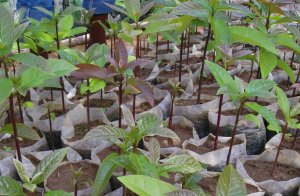On the hilly slopes of Rwanda, the new agroforestry project by Livelihoods & ARCOS will bring agroforestry at scale for the benefit of more than 30, 000 smallholder farmers. But what does a farm look like today? What are the everyday challenges the households are facing? How can the agroforestry model contribute to provide more resources to the smallholder farmers while restoring soil health?
Land scarcity due to population density
In Rulindo and Bugesara districts where the Livelihoods-ARCOS project will be implemented, the size of most farms is only about 0,5 hectares. In most cases, this is not enough to ensure the food security of a whole family of three kids, that sometimes also include the grandparents. The lack of land due to population density has led to intensive agricultural practices. Today, most of the farmers produce cash crop and sell it to cover the family’s needs: women often take care of the farm, while men need to work in the city to generate enough income for the household.
A farming model with little space for land restoration
With two cropping seasons running from March to August and from September to February, the main crops cultivated in Rwanda are maize, beans, and sweet potatoes, while cassava and banana are mostly cultivated in the lowlands. In Rulindo district, farmers can also grow tea as a monoculture for several years.
The predominant system is a succession of cereal and leguminous crop. When a region produces cereals, the other is producing beans. Once cereals like maize or sorghum are harvested, farmers must prepare land to sow leguminous crop (beans or peas). Corn stalks are used as climbing stems for beans and other crop residues are used for animal fodder. In this farming model, there is little organic matter left in the soil, and no space to fallow the land. In turn, this does not leave enough time for the land to regenerate, and farmers become dependent on external chemical outputs.
This current agricultural model has also reduced the available space for growing vegetables: these have been reduced to small kitchen gardens of less than 25m2. With a diversity of vegetables highly decreasing, households are now forced to purchase externally what was previously produced in their own farm.
The impacts of deforestation:
In Rwandan farms, very little trees are left and only around 5% of farmers own private woodlots. Generally collected by children in neighboring farms, wood is used for cooking and warming the house. But the resources in wood are now very scarce in the project area.
The current Rwandan farming model is simplified, leading to soil loss and depletion of nutrients with an accentuated risk due to heavy rains falling on the steep slopes and no trees left to retain the water in the soil.
Livelihoods-ARCOS agroforestry model will couple soil health, food security and improved income

All farmers involved in the project will be provided with an average of 200 trees per hectare, including fruit trees, native species, and fast-growing species. The trees will protect the soil from erosion, and provide organic matter to increase its fertility but also fruit to the families. The branches of the newly grown trees will provide wood for cooking or for making stems. On tea farms, in addition to providing wood for the households, trees will be used as shade trees to enhance tea production and create new sources of income.
Improve the livelihoods or rural communities is at the heart of the model: the farmers will be provided with some ruminants to diversify their diet but also promote the use of manure. The project will increase the share of organic fertilizer to lower the quantity of chemical inputs and increase soil health. Current practices of mulching will also be improved thanks to Livelihoods-ARCOS agroforestry model: some farmers are still burning their crop residues or using eucalyptus leaves as main raw material which acidifies the soil. Mulching application will be extended to cereals, whereas today they are only used for vegetables garden, which represent only a small portion of the land.
The project is also willing to re-introduce vegetable diversity such as garlic, peppers, onions, fresh beans, and tomatoes to improve and diversify family diets. Reintroducing trees, plant diversity and improving agricultural practices like mulching, intercropping, production of organic compost and even terracing, will contribute to making the farming system more resilient.


